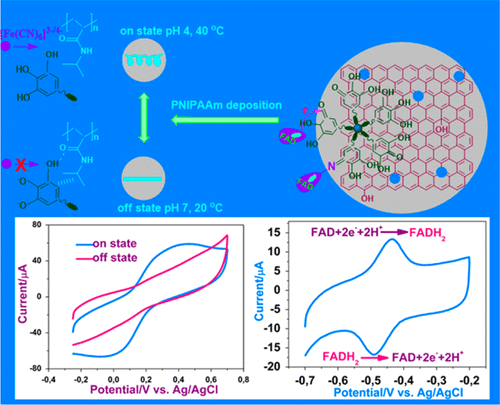当前位置:
X-MOL 学术
›
ACS Sustain. Chem. Eng.
›
论文详情
Our official English website, www.x-mol.net, welcomes your
feedback! (Note: you will need to create a separate account there.)
Tannic Acid-Reduced Graphene Oxide Deposited with Pt Nanoparticles for Switchable Bioelectronics and Biosensors Based on Direct Electrochemistry
ACS Sustainable Chemistry & Engineering ( IF 7.1 ) Pub Date : 2018-01-11 00:00:00 , DOI: 10.1021/acssuschemeng.7b04164 Bilge Akkaya , Bekir Çakiroğlu , Mahmut Özacar
ACS Sustainable Chemistry & Engineering ( IF 7.1 ) Pub Date : 2018-01-11 00:00:00 , DOI: 10.1021/acssuschemeng.7b04164 Bilge Akkaya , Bekir Çakiroğlu , Mahmut Özacar

|
In this study, we reported a novel biosensor based on direct electrochemistry of glucose oxidase (GOx) on a tannic acid-reduced graphene oxide nanocomposite modified glassy carbon electrode deposited with Pt nanoparticles. Tannic acid (TA) was utilized for the simultaneous green reduction of Pt4+ and graphene oxide (GO), along with modifying the reduced GO for the GOx immobilization, thus constructing a switchable surface with pH and temperature alterations. Upon the electrochemically oxidation of TA to quinone, enhanced electron transfer was obtained, and a third generation biosensor was fabricated using π–π interaction between GO and TA and Schiff-base assisted hydrogen bonds between GOx and TA interactions. The redox peaks were observed at a formal potential of −0.462 V with a peak separation (ΔEp) of 56 mV, which reveals the fast electron transfer. The linear response to glucose oxidation was in the range of 2–10 mM with a limit of detection of 1.21 μM and a sensitivity of 27.51 μA mM–1 cm–2. Upon the deposition of poly(N-isopropylacrylamide) (PNIPAAm) onto the constructed biosensor via hydrogen bonds, an on–off biosensor was fabricated with zipperlike interfacial properties upon the formation of the shrunken and compact globule PNIPAAm structure and varying surface charge. Therefore, this study confirmed the versatile aspects of natural TA without using complicated methods.
中文翻译:

基于直接电化学的可切换生物电子和生物传感器用铂纳米粒子沉积单宁酸还原的氧化石墨烯
在这项研究中,我们报道了一种基于葡萄糖氧化酶(GOx)直接电化学的新型生物传感器,该传感器在单宁酸还原的氧化石墨烯纳米复合改性玻碳电极上沉积了Pt纳米颗粒。单宁酸(TA)用于同时还原Pt 4+和氧化石墨烯(GO)的绿色,同时修饰还原的GO以固定GOx,从而构建具有pH和温度变化的可切换表面。将TA电化学氧化为醌后,获得了增强的电子转移,并使用GO和TA之间的π-π相互作用以及GOx和TA相互作用之间的席夫碱辅助氢键制造了第三代生物传感器。在-0.462 V的形式电位下观察到的氧化还原峰具有峰分离(ΔE p)为56 mV,显示出快速的电子转移。葡萄糖氧化的线性响应范围为2–10 mM,检出限为1.21μM,灵敏度为27.51μAmM –1 cm –2。当聚(N-异丙基丙烯酰胺)(PNIPAAm)通过氢键沉积到所构造的生物传感器上时,就形成了具有拉链状界面特性的开-关生物传感器,该传感器具有收缩且致密的球状PNIPAAm结构并具有变化的表面电荷。因此,这项研究证实了天然TA的通用性,而无需使用复杂的方法。
更新日期:2018-01-11
中文翻译:

基于直接电化学的可切换生物电子和生物传感器用铂纳米粒子沉积单宁酸还原的氧化石墨烯
在这项研究中,我们报道了一种基于葡萄糖氧化酶(GOx)直接电化学的新型生物传感器,该传感器在单宁酸还原的氧化石墨烯纳米复合改性玻碳电极上沉积了Pt纳米颗粒。单宁酸(TA)用于同时还原Pt 4+和氧化石墨烯(GO)的绿色,同时修饰还原的GO以固定GOx,从而构建具有pH和温度变化的可切换表面。将TA电化学氧化为醌后,获得了增强的电子转移,并使用GO和TA之间的π-π相互作用以及GOx和TA相互作用之间的席夫碱辅助氢键制造了第三代生物传感器。在-0.462 V的形式电位下观察到的氧化还原峰具有峰分离(ΔE p)为56 mV,显示出快速的电子转移。葡萄糖氧化的线性响应范围为2–10 mM,检出限为1.21μM,灵敏度为27.51μAmM –1 cm –2。当聚(N-异丙基丙烯酰胺)(PNIPAAm)通过氢键沉积到所构造的生物传感器上时,就形成了具有拉链状界面特性的开-关生物传感器,该传感器具有收缩且致密的球状PNIPAAm结构并具有变化的表面电荷。因此,这项研究证实了天然TA的通用性,而无需使用复杂的方法。









































 京公网安备 11010802027423号
京公网安备 11010802027423号